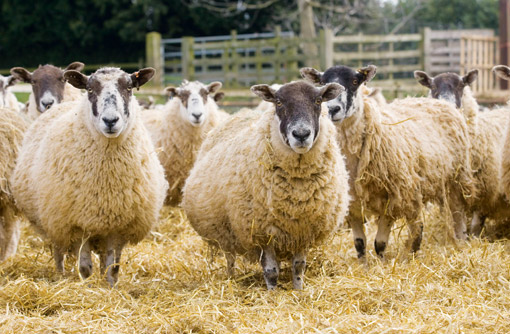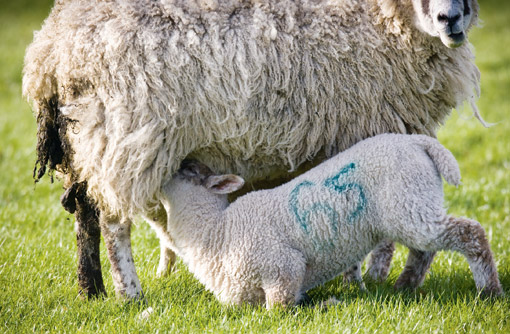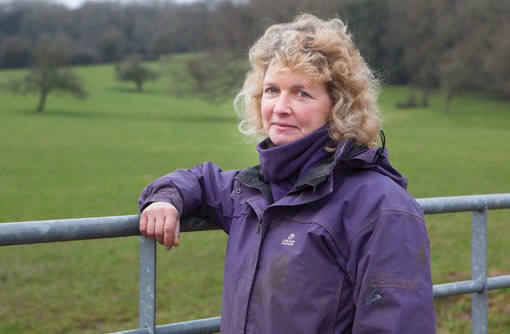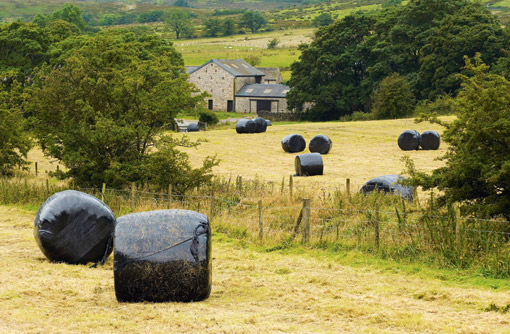Tips on using diet to prevent ewe setbacks

After the atrocious weather of last summer and an autumn tupping time that gave little respite, the first signs that this spring’s lambing time could yield some nasty surprises has come with early scanning results.
While it’s bad enough that fecundity has suffered, the main concern in the run-up to lambing is ewes that have managed to conceive could deliver lambs of lower birthweights and may themselves be under more nutritional stress, pre-disposing them to a higher risk of twin-lamb disease.
Vets and nutritionists say there’s still time to address late pregnancy nutrition if producers act fast and ensure they work with precise knowledge of what their feeds are offering – both forage and concentrates – and target ewes most at risk.
Many silage analyses are showing low protein and energy levels but, unless the shortfalls of forages are met with precise supplementary feeding, twin-lamb disease will be a major threat.
But once lambed, even ewes that have endured a negative energy diet during late pregnancy and avoided any major setback, are more at risk of producing less viable lambs, have poor colostrum production and lower milk output.
What are the potential problems if I don’t get nutrition right?
Figures show there is a 70% mortality rate in ewes suffering from twin-lamb disease – that amounts to a significant loss in ewe value, plus lower lamb income if lambs are hand-reared.
Joe Henry of Alnorthumbria Vet Group fears there will be a significant increase in twin-lamb disease this spring.
“Ewes have had a very hard time and as well as the serious fluke problems we’re seeing, it’s likely worm burdens are higher too – it’s all taking its toll on the heavily pregnant ewes.”
Flocks coming to the trough for concentrates will quickly show up any individuals off their feed – and that could mean twin-lamb disease. Anyone feeding TMR diets must be acutely aware because ewes aren’t competing for food and sick individuals are harder to notice.
Ewes identified as having twin-lamb disease need “swift and sustained” treatment for 24 hours to restore their blood glucose level. “It’s no good giving one drench. The ewe must be treated repeatedly and given four drenches in the first day,” says Mr Henry.
And it’s important not to make sudden changes to the diet. If the quality of the feed has to be increased or a new ration introduced, it must be done over a period of days – and that diet must be fed through to lambing. Repeated diet changes – even rations bought from different manufacturers – can trigger milk fever – a calcium deficiency that can show as weakness and staggers or even death.
Small or weak lambs that have to be supplemented with colostrum need 50ml for every kilo in weight in the first 12 hours of life. Underfed ewes can’t produce that amount of colostrum and lambs will suffer as a consequence. They are then at greater risk of watery mouth, joint ill and other neo-natal illnesses.
How do I ensure ewes are getting what they need?
Lower energy and protein levels are widespread problems in silage this year and digestibility is poor. Some proteins are as low as 9% when they should be 14%, so it’s essential to have all silages analysed.
Vets advise blood-sampling ewes three to four weeks before lambing to produce a clear picture of their dietary needs. A flock profile is obtained by taking bloods from six twin-bearing ewes, six triplets and six gimmers carrying twins.
Taking the bloods at exactly three weeks pre-lambing means ewes are caught at precisely their metabolic knife-edge, says Mr Henry.
“Take the sample too early and things can look OK, but the wheels fall off later. Take them too late and there isn’t time to fix the problem.”
The blood sample will show the critical level of the ewe’s beta-hydroxybutyrate – a measurement of how much the ewe is breaking down her body reserves. If that’s happening too rapidly it’s essential to address feed intakes to counter the problem.
Urea levels indicated by the blood sample will also show short-term protein status, which needs to be high at this stage of pregnancy – a time when mammary development and colostrum production is taking place.
Protein
“If the urea level is low, the quality and quantity of the additional feed must be increased to ensure there’s enough milk for the lambs. But while a ration may look OK on paper, it won’t always fulfil the real dietary needs of the ewe.
Blood sampling is the only way to actually ask the ewe what she really needs in her diet.
“Silage is so variable, even from bale to bale, that blood sampling is the only way to get a true picture,” says Mr Henry.
Simply feeding more cake may not be the solution if the cake isn’t supplying the ewe’s needs. A 16% cake fed with a low-protein silage isn’t enough for heavily in-lamb ewes – even if more of the cake is fed. With advice from the vet it’s probably going to need changing to an 18% or 19% protein ration to do the trick.
Energy
Ewe diets post-lambing should be high in energy – a ewe has a higher energy need when she’s milking than she does when she’s pregnant. Where grass is in short supply after lambing it’s important to maintain supplementary feeding – and it may be a lot more than most sheep producers think is necessary.
Mr Henry comments: “Care must be taken to avoid mis-mothering when feeding ewes, but a ewe that’s not milking well because she’s underfed is more prone to mastitis. After a cold night ewes will shelter and if lambs are drawing on an empty bag the teats get damaged and in goes the bacteria.
“Cake is expensive but a strong Mule ewe with twins can eat at least 1kg of feed a day – and even that may not be enough. But only feed 0.5kg at a time or acidosis is a problem. If grass is still short after two weeks post-lambing, a ewe with twins could need 1.5kg of cake a day fed in three feeds.”
| Comparing the energy cost of cereals with the best-value feeds | ||||
| Price (£/t) | Dry matter (%) | Energy (MJ ME/kg DM) | Energy cost(p/10MJ ME) | |
| Cereals |
|
|
|
|
| Barley | 220 | 86 | 13.2 | 19.4 |
| Wheat | 235 | 86 | 13.7 | 19.9 |
| Digestible fibre feeds |
|
|
|
|
| Wheat feed | 190 | 86 | 11.7 | 18.9 |
| Sugar beet feed | 230 | 89 | 12.5 | 20.7 |
| Soya hulls | 220 | 89 | 11.8 | 20.9 |
| Liquid feeds |
|
|
| |
| Bioethanol wheat distillery syrup | 50 | 24 | 14.0 | 14.9 |
| Source: Trident. Prices quoted correct at time of going to press, 29t bulk loads for November-April delivery on farm, within 50 miles of source. Prices will vary with load sizes and distance from source | ||||
| Ewe energy supplementation: impact on lamb performance | ||||
|
| Twin-suckling ewes | Triplet-suckling ewes | ||
|
| Control | Control + energy supplement | Control | Control + energy supplement |
| Percentage of ewes rearing all lambs | 90 | 95 | 60 | 100 |
| Lamb gain to weaning (g/day) | 218 | 233 | 170 | 203 |
What kind of diets should I feed?
The nutritional needs of a pregnant or lactating ewe haven’t changed because feed prices have soared, says Michael Marsden of Trident Feeds.
Rather than focusing on cost a tonne, he recommends comparing different feeding strategies on the basis of their value.

“Liquid feeds have been one of the best-value feeds this year. Molasses-based products that also contain extra-effective protein (in the form of slow-release urea) compare well against traditional protein sources such as rape meal, while the new distillery syrups that are becoming increasingly available are naturally high in both energy and protein.
“A number are from sources other than the whisky industry and so have a low copper content that is ideal for sheep feeding,” says Dr Marsden.
Liquid feeds are an option for pregnant or lactating ewes, and can easily be incorporated into most feeding systems by using lick feeders or dribbling on top of forages or other feeds offered in a trough.
“They are particularly useful for supplementing thin ewes or ewe lambs still growing or feeding alongside this year’s poorer-quality silages to supply additional energy. Liquid feeds are a good opportunity this winter,” he says.
A pelleted blend may offer the best combination of low cost and simplicity this year. “Aim for an energy content of at least 12.5MJ ME/kg DM, plus 16-18% crude protein if feeding hay or silage, or 20% for straw-based rations.
David and Jane Cutter, Monkhill Farm, Blaisdon, Gloucestershire

The Cutters run 400 ewes – Lleyn, Welsh Mule and Texel cross Welsh – at Monkhill Farm, Gloucestershire. They have been analysing their big-bale silage for the past few years and say it’s definitely given them far more control when feeding in-lamb ewes.
“Knowing the quality and feed value of the silage means we can adjust concentrate feeding accordingly. It makes sure we’re feeding the flock more effectively in terms of ewe condition and the number of lambs they are carrying, but it also means we’re not overfeeding – and that’s saving on costs,” says Mrs Cutter.
The flock lambs indoors in March. Despite the weather, the Cutters say last season’s silage has analysed “remarkably well.”
“We had protein levels up to 22%. We cut the grass quite young and most of it was fairly new leys. Ewes are grouped according to scanning or body condition, but they all get the same silage.
“Singles don’t get any concentrates unless their body condition demands it, but knowing the quality of the silage means we’ve got greater control over the amount of concentrates we feed,” says Mrs Cutter, who will be feeding an 18% concentrate.

Last year, to balance the big-bale silage, ADAS sheep specialist Kate Phillips recommended feeding a supplementary concentrate featuring rumen-protected fat. It comprised 18% CP and 13MJ/kg ME and was fed to ewes scanned with twins and triplets during the last six weeks of pregnancy.
It bridged the ewes’ natural energy deficit during late pregnancy and met the needs of the growing lambs, says Volac’s Jeannie Everington. The benefits of feeding concentrate during that period have been highlighted in a Volac trial.
“During the final five to six weeks of pregnancy lambs reduce the physical size of the rumen, making it difficult for the ewe to eat enough to satisfy her energy demands. She needs to produce sufficient high-quality colostrum and milk to get lambs off to the best start and may lose condition rapidly leading to serious health issues, including twin lamb disease,” says Mrs Everington.
Trial work at ADAS Rosemaund showed the importance of diets fed to in-lamb ewes during late pregnancy and early lactation that contained rumen-protected fat as a source of supplementary energy.
The trial showed that ewes carrying twins reared 95% of their lambs, 5% more than those fed the control diet. The trend was more apparent in the triplet group, where all the ewes reared 100% of their lambs, compared with only 60% of lambs successfully reared by those fed the control diet.
Ewes fed rumen-protected fat were in better body condition at weaning, scoring an average 2.4 compared with 2.0 for the ewes fed the control diet.
Stan Willis, Braeside Farm, Denwick, near Alnwick, Northumberland
Northumberland sheep producer Stan Willis knows only too well about the problems caused by sudden changes to diet and management of in-lamb ewes.
It was only after the swift intervention of his vet that he saved all but one of 14 in-lamb Mule ewes when they suddenly went down with twin-lamb disease three days after they were housed – even though the ewes had been receiving adequate nutrition at grass.
Mr Willis of Braeside Farm, Denwick, near Alnwick, says the ewes were three weeks away from lambing and had been trough fed in the field and had hay offered in racks.
Twin-lamb disease facts
- Twin-lamb disease affects ewes in late gestation when their energy requirements exceed energy intakes
- Signs are weakness and recumbancy, failure to come to feed trough, and dull and depressed appearance
“We brought them inside and everything seemed fine, but on the third day I noticed one ewe looked as though she didn’t know where she was and there were others who were trembling and looking sick.
“The vet took some samples and confirmed twin-lamb disease, but we couldn’t understand why they had gone down with it when they’d been fed as normal and even had hay before they came inside,” says Mr Willis.
The outbreak was triggered by the sudden change late in pregnancy and because it was thought they hadn’t been taking much hay when there was plenty of grass.
“We lamb in late March but we now start feeding ewes from early January with just 113g a head to start with. We house six weeks before lambing so they’ve got plenty of time to adjust to the change and get used to eating hay. By housing sooner the ewes aren’t as vulnerable as they would be if we housed later and they had to get used to a new forage diet later in the pregnancy.”
